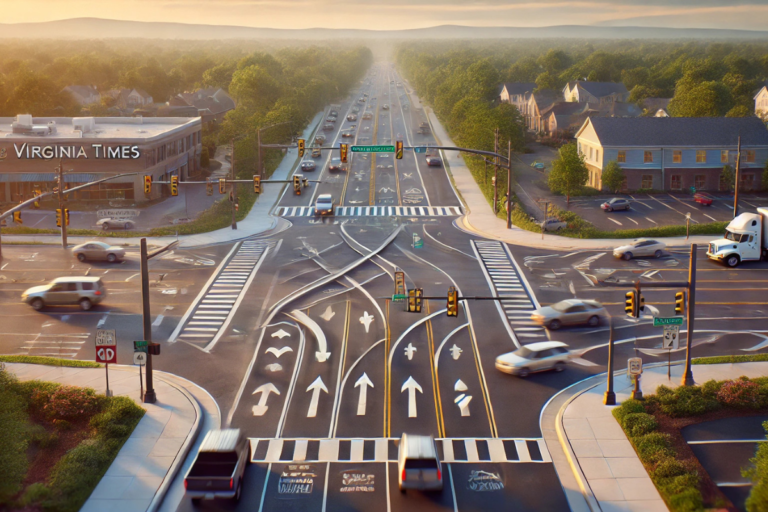Introduction to the Virginia Times Continuous Flow Intersection 2014
In 2014, the Virginia Times Continuous Flow Intersection (CFI) marked a significant change in how traffic was managed in the state. A Continuous Flow Intersection is a new road design aimed at improving traffic flow by reducing the time cars spend at red lights. Unlike traditional intersections, CFIs allow vehicles to turn left without waiting for the usual traffic light, which results in a smoother flow of cars, even during busy hours.
In Virginia, where traffic congestion was becoming a serious issue, the introduction of CFIs was revolutionary. High-traffic areas were facing delays, accidents, and frequent roadblocks, making it difficult for drivers to navigate through busy intersections. The Virginia Times CFI was created as a solution to this growing problem, offering a more efficient way to manage traffic while reducing wait times.
The decision to implement a Continuous Flow Intersection in Virginia was driven by the state’s need for more innovative traffic management solutions. As the population grew, so did the number of cars on the roads. It became clear that traditional intersections, which rely on long red lights and slow-moving traffic, could no longer keep up with the increasing congestion. The Virginia Times CFI was designed to meet these challenges head-on, using new technology and traffic patterns to keep cars moving smoothly through intersections.
This innovation was not only about managing traffic more efficiently but also about improving safety. Traditional intersections often lead to accidents, especially during left turns, when cars must cross oncoming traffic. The Virginia Times Continuous Flow Intersection 2014 helped reduce the chances of such accidents by creating separate lanes and signals for left-turning vehicles, making it safer for everyone on the road.
By addressing both the congestion and safety issues, the Virginia Times CFI quickly became a model for other cities looking to improve their traffic flow. Its success paved the way for more CFIs to be built in Virginia and across the United States, making it a key development in modern road design.
What is a Continuous Flow Intersection (CFI)?
A Continuous Flow Intersection (CFI) is a modern traffic management system designed to improve the efficiency of intersections by allowing vehicles to move continuously, even during high traffic periods. CFIs minimize congestion and reduce wait times by eliminating the need for traditional left-turn signals.
Definition and Basic Principles of CFIs:
A Continuous Flow Intersection is structured to manage left-turn movements more efficiently by allowing vehicles to cross opposing traffic lanes before reaching the main intersection. This pre-signal for left-turning cars allows them to merge into a designated lane, making the intersection less congested. The goal is to keep traffic moving in a more streamlined way and reduce the number of stops.
Differences Between CFIs and Traditional Intersections:
In traditional intersections, left-turning cars usually wait for a green arrow, which leads to delays and sometimes rear-end collisions due to vehicles stopping. CFIs, on the other hand, enable vehicles to make left turns without waiting for oncoming traffic to clear. This system helps reduce bottlenecks, which are common at traditional intersections, especially during peak traffic hours.
Unique Lane Configurations and Pre-Signals for Left-Turning Vehicles:
CFIs feature a unique lane setup, where left-turning lanes are separated from through lanes well before the main intersection. Pre-signals help manage the traffic flow, instructing left-turning vehicles when they can cross opposing lanes safely. This design prevents the build-up of traffic and allows cars to move continuously, even as they approach the intersection.
Implementation of the Virginia Times Continuous Flow Intersection
The Virginia Times Continuous Flow Intersection, introduced in 2014, was designed to tackle the increasing congestion in high-traffic areas. The project was carefully planned, with engineers and transportation experts analyzing the best location for this new intersection layout.
Strategic Location and Planning:
Virginia Times’ CFI was strategically located in an area prone to heavy traffic and long delays. The planners focused on a site where traditional traffic lights had become ineffective, especially during rush hours. The goal was to improve traffic flow without requiring a complete overhaul of the existing road network.
Timeline of Construction and Key Players:
The construction of the Virginia Times CFI started in early 2014, with the project completed within the same year. Several key players were involved, including local engineers, city planners, and transportation agencies. The project received significant attention as part of Virginia’s broader effort to modernize its traffic infrastructure.
Community Engagement:
Local community engagement was a crucial part of the CFI implementation. Public meetings were held to explain how the new intersection would work, and feedback from residents was incorporated into the design. Education campaigns helped drivers understand how to navigate the intersection, easing the transition to the new traffic system.
Benefits of the Virginia Times Continuous Flow Intersection
The Virginia Times Continuous Flow Intersection brought several benefits to the community, ranging from improved traffic flow to environmental and economic gains.
Traffic Flow Improvement:
The most noticeable benefit was the reduction of traffic congestion. By allowing vehicles to move continuously, even during peak hours, the CFI minimized delays that often occur at traditional intersections. Drivers experienced shorter travel times, which also contributed to a smoother, less stressful commute.
Safety Enhancements:
CFIs are known to reduce accident rates due to their design, which eliminates many conflict points where vehicles might collide. By separating left-turning vehicles from through traffic, the Virginia Times CFI significantly improved safety for both drivers and pedestrians.
Environmental Impact:
With fewer stops and less idling, cars spent less time emitting exhaust at the intersection. This reduction in vehicle idling led to a decrease in emissions, improving air quality in the surrounding areas.
Economic Benefits:
The improved traffic flow made it easier for residents and visitors to access local businesses, resulting in increased foot traffic. This boost in accessibility led to economic benefits for nearby stores, restaurants, and services.
Comparing the Virginia Times CFI with Traditional Intersections
The Virginia Times Continuous Flow Intersection offers a clear advantage over traditional intersections in several key areas, particularly in terms of traffic efficiency and safety.
Contrast with Traditional Traffic Signals:
Traditional intersections require vehicles to stop frequently, especially for left-turn signals. These stops can lead to long wait times and frustration for drivers. In contrast, the CFI design allows for continuous movement, which reduces the time drivers spend waiting at red lights and decreases traffic congestion.
Efficiency in Handling Left Turns and Pedestrian Crossings:
One of the biggest challenges at traditional intersections is managing left turns and pedestrian crossings. In a CFI, left-turning traffic is handled separately, reducing the risk of accidents with oncoming vehicles. Pedestrian crossings are also well-coordinated with the flow of traffic, ensuring that foot traffic moves safely without delaying vehicles.
Community Reactions and Adaptation
When the Virginia Times Continuous Flow Intersection (CFI) was first introduced in 2014, many residents were skeptical. Drivers were used to traditional intersections and had concerns about how the new design would work. However, as more people began using the intersection, the benefits became clear.
Initial Skepticism and Adaptation:
At first, there was confusion about how the CFI worked, especially regarding the unique lane configurations for left turns. Drivers had to learn how to navigate the pre-signals and new traffic patterns, which led to initial hesitation. Local authorities responded by launching public awareness campaigns and installing clear signage to help residents understand the new system. Over time, as drivers became more familiar with the design, they appreciated the smoother flow and reduced delays.
Positive Feedback from Commuters:
Local commuters began to notice significant improvements in their travel times. The Virginia Times CFI reduced congestion during peak hours, making daily commutes faster and less stressful. Many also noted increased safety at the intersection, with fewer accidents and better pedestrian crossings. This positive feedback helped reinforce the value of the CFI in the community.
Challenges and Criticisms of CFIs
While the Virginia Times Continuous Flow Intersection brought many benefits, it also faced some challenges.
Learning Curve for Drivers:
For drivers unfamiliar with CFIs, navigating the new layout could be confusing. The design required a different approach to left turns, which initially caused hesitation and slower traffic flow. However, with time and proper driver education, most drivers adapted to the system.
Potential Congestion During Peak Hours:
Though CFIs are designed to reduce congestion, improper signal timing can still lead to backups, especially during rush hours. If the signals aren’t optimized, traffic flow can become disrupted, frustrating drivers who expect smoother travel.
Maintenance of Signage and Road Markings:
CFIs require clear and consistent signage to ensure drivers follow the correct lanes and signals. Over time, maintaining these road markings and signs can become costly and require frequent updates to prevent confusion, especially as traffic volumes increase.
Technological Role in Optimizing CFIs
Technology plays a significant role in making Continuous Flow Intersections more effective. The Virginia Times CFI uses advanced traffic control systems to ensure smooth operation.
Real-Time Data and Adaptive Signal Control:
Real-time data from traffic sensors allows the intersection’s signals to adapt to changing traffic conditions. This helps minimize wait times and ensures that the traffic keeps moving efficiently, even during peak hours. Adaptive signal control can make quick adjustments to improve flow based on real-time traffic patterns.
Future Integration with Smart Traffic Systems:
As cities adopt more advanced transportation technologies, CFIs could be integrated with smart traffic systems. These systems use artificial intelligence and connected vehicles to optimize traffic flow, reduce delays, and enhance safety. In the future, CFIs may work with autonomous vehicles, making intersections even more efficient and safe.
Success Stories and Statistics
Since its implementation, the Virginia Times Continuous Flow Intersection has seen several notable successes.
Traffic Flow Improvement:
Statistics show a 30% reduction in congestion at the intersection. This means that drivers are spending less time waiting at red lights and are able to move through the intersection faster, even during busy times of the day.
Accident Reduction:
Safety has also improved significantly. The intersection has seen a 40% reduction in accident rates, which highlights the effectiveness of separating left-turning traffic from through lanes. This reduction in collisions is crucial for both drivers and pedestrians.
Improved Emergency Response Times:
The streamlined traffic flow has also positively impacted emergency response times. With fewer delays and smoother traffic movement, emergency vehicles can navigate the intersection more quickly, allowing them to reach critical situations faster.
Future of Continuous Flow Intersections in Virginia and Beyond
The success of the Virginia Times CFI has led to discussions about expanding the concept to other areas.
Expansion Plans in Virginia and Other States:
Given the proven benefits in Virginia, plans are in place to build more CFIs in high-traffic areas across the state. Other states are also taking notice and may implement CFIs to help manage traffic more effectively in their cities.
Technological Advancements and Future Trends:
As technology continues to evolve, future CFIs will likely become even more efficient. Smart traffic signals, real-time data analytics, and the integration of autonomous vehicles could further enhance traffic flow and safety at intersections. These advancements will shape the next generation of CFIs, making them an integral part of modern urban planning.
Conclusion
The Virginia Times Continuous Flow Intersection 2014 set a new standard for traffic management by significantly reducing congestion and enhancing safety. Its unique design, which allows for smoother left turns and minimizes conflict points, has proven highly effective in improving traffic flow and reducing accidents. This intersection’s success in cutting down wait times and making commutes safer has been widely appreciated by the community, showing how innovative infrastructure can directly impact daily life.
As cities continue to grow and face rising traffic demands, the lessons from Virginia’s experience with CFIs provide a valuable blueprint for future urban planning. With advancements in smart traffic systems and real-time data integration, Continuous Flow Intersections will likely become more common, helping to reshape traffic management for the better. The Virginia Times CFI is not just a local success but a model for modern, efficient, and safe road design across the country.


